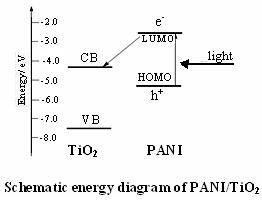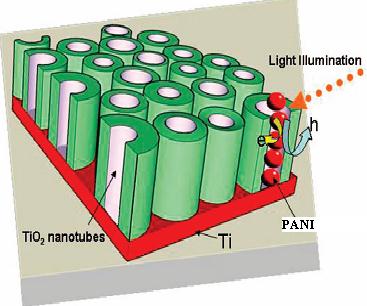Nano-structured composite metallic oxide/polymeric materials for photoelectrochemical energy conversion applications
graduate students: Hatem
Why solar??
- Environmentally friendly renewable energy source.
- Power source for outer space applications.
- Cost-effective way to provide power to remote areas.
A surface consisting of a combination of both organic and inorganic material as an electrode for photogalvanic cells has been developed. Therefore, it combines the unique properties of inorganic semiconductor nano-structures with those of organic polymeric materials. Organic materials are inexpensive, easily processable and their functionality can be tailored by molecular design and chemical synthesis. On the other hand, inorganic semiconductors can be manufactured in the nano-size, thus offering the advantage of having high absorption coefficients and size tunability. By varying the size of the nano-structures the band gap can be tuned, therefore the absorption range can be tailored. In addition to this, low cost synthesis, processability and versatile manufacturing of thin film devices make them attractive. Thus, the organic/inorganic hybrid concept for photovoltaic solar cell electrodes is attracting interest in recent years. Compared with randomly distributed titania nanowires, the well-aligned titania nanotubes arrays, especially the single crystalline one, enhanced the charge collection and transport rate and in turn the light conversion efficiency.
When PANI/TiO2 nanocomposites are illuminated, both TiO2 and PANI absorb the photons at their interfaces and then charge separation occurs at the interface. Since the conduction band of TiO2 and the LUMO level of the PANI are well matched for the charge transfer, the generated electrons by inducing PANI can be transferred to the conduction band of TiO2, enhancing the charge separation and in turn promoting the photocatalytic ability.

The architecture of the composite material is very vital. A schematic diagram of PANI/TiO2 composite synthesized is depicted in the following figure. The photoelectrons generated in PANI pass through the TiO2 NTs and finally reach the back contact smoothly because of the one-dimensional (1D) nature of the nanotubes.

References
"Advanced nanostructured polymeric materials for energy conversion applications" Hatem Amin, Masters' Thesis, Chemistry Department, Faculty of Science, Cairo University